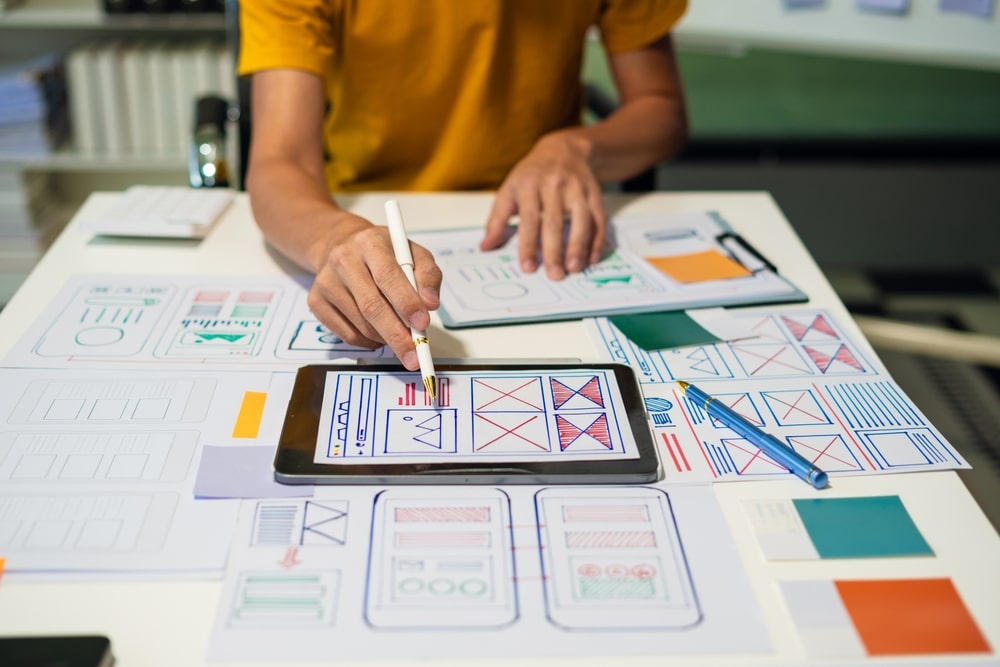What is UX/UI? It’s the invisible force that makes you swipe right on some apps and rage-quit others within seconds. Behind every digital experience that delights you—or frustrates you to no end—lies the calculated science and artistic intuition of UX/UI design.

Think about the last time an app or website felt so natural to use that you barely noticed the interface, or conversely, when you abandoned a digital product because it was confusing or visually chaotic. That’s the power of these twin disciplines at work.
In this age where the average person touches their phone more than a hundred times daily, the difference between exceptional and mediocre design isn’t just aesthetic—it’s the difference between capturing attention and losing customers forever.
The 5 Essential Elements of UX Design
At the heart of what is UX/UI lies a framework developed by designer Jesse James Garrett that has become the industry standard for creating meaningful digital experiences. This framework consists of five elements that progress from abstract to concrete.
1. Strategy
The strategy element forms the bedrock of any successful UX/UI project. At this most abstract level, designers must answer fundamental questions: What problem is this product intended to solve? Who are the users, and what are their needs? What are the business goals?
This first step involves extensive research to understand user pain points and business objectives. When strategy is neglected, the ripple effects are felt throughout the entire project lifecycle. A well-defined strategy ensures that all subsequent design decisions serve both user needs and business goals, creating digital products that are not just beautiful but purposeful.
2. Scope
Once the strategy is established, the scope element focuses on what exactly will be built to address the identified problems. This involves determining functional requirements (what features to include) and content requirements (what information to present).
The scope phase transforms abstract ideas into concrete plans, establishing boundaries for the project. It’s where designers and stakeholders decide what’s in and what’s out, preventing feature creep and ensuring resources are allocated effectively. A well-defined scope keeps projects on track and aligned with strategic objectives.
3. Structure
The structure element addresses how the design is organized and how interactions work. This includes information architecture (how content is structured and categorized) and interaction design (how users move through and engage with the product).
Structure is where designers begin to map user journeys and create logical pathways through content. A coherent structure ensures users can find what they need intuitively, without confusion or frustration. This element bridges the gap between abstract concepts and tangible design elements.
4. Skeleton
The skeleton element begins to consider the presentation and arrangement of information. This includes UI design (interface elements), navigation design (how users move through the system), and information design (presenting information for optimal understanding).

At this stage, designers typically create wireframes—simplified visual representations of the interface that show layout and functionality without detailed visual design. The skeleton ensures that information hierarchy is clear and that users can easily navigate through the experience.
5. Surface
The surface element is where UI design takes center stage. This most concrete level focuses on how the product looks and feels to users, including visual elements like color schemes, typography, imagery, and animations.
While this is the layer users directly interact with, its effectiveness depends entirely on the solid foundation built through the previous four elements. A visually stunning interface built on poor strategy, scope, structure, or skeleton will ultimately fail to meet user needs or business objectives.
What is the Relationship Between UX and UI?
Understanding what is UX/UI requires recognizing that while user experience (UX) encompasses the entire process across all five elements, user interface (UI) primarily focuses on the surface layer. However, the two disciplines are inseparable, working in tandem to create cohesive digital experiences.
UX design ensures that products are useful, usable, and desirable, while UI design makes them visually appealing and intuitive. Together, they create experiences that not only look good but also work well and fulfill user needs.
How UX/UI Impacts Search Rankings?
UX/UI design isn’t just about pleasing users—it also significantly impacts search engine optimization or SEO. Google’s algorithms increasingly prioritize user experience signals when determining search rankings.
Well-structured content with clear headings, concise paragraphs, and appropriate use of lists not only improves readability for users but also helps search engines understand and index your content. Mobile-friendly designs, fast loading times, and intuitive navigation all contribute to better SEO performance.
When users find your content valuable and easy to consume, they stay longer, engage more, and may share your content—all positive signals that can boost your search rankings.
The Business Impact of Effective UX/UI Design
The 5 essential elements of UX/UI design aren’t just theoretical concepts—they have real-world business implications. When digital products are built with these elements in mind, they tend to work in your favour.
They increase user engagement and retention, reduce development costs by identifying issues early, improve conversion rates and customer satisfaction, build brand loyalty and positive word-of-mouth and in the end they provide competitive advantage in crowded markets.
Mastering what is UX/UI has become essential for business success. The companies that invest in thoughtful, user-centered design across all five elements consistently outperform those that treat design as merely a surface-level concern.
As we continue to navigate an increasingly digital world, the principles of UX/UI design will only grow in importance. By understanding and applying the 5 essential elements—strategy, scope, structure, skeleton, and surface—designers and businesses can create digital experiences that not only meet user needs but exceed expectations, driving both user satisfaction and business success.
The Evolution of UX/UI
As we look toward the future of UX/UI design, several fascinating developments are reshaping how we interact with digital products. By 2025, we’re seeing a dramatic shift in what users expect and what designers can deliver.

AI as a Creative Partner
AI is no longer just a buzzword but a powerful ally in the design process. Rather than replacing designers, AI is becoming an essential partner that handles repetitive tasks while allowing human creativity to flourish. This collaboration is enabling unprecedented levels of personalization, with interfaces that adapt in real-time to individual user preferences and behaviors.
Beyond Flat Screens
The digital experience is breaking free from traditional screens. Interactive 3D objects, spatial navigation, and immersive VR/AR experiences are becoming mainstream expectations. These technologies are opening entirely new possibilities for how users interact with content, from virtual try-ons for clothing to immersive skill-building simulations.
The 50-Millisecond Rule
Did you know it takes just 50 milliseconds—less than a blink of an eye—for users to form an opinion about a website? This tiny window makes every design decision crucial. This insight has pushed designers to perfect those critical first impressions through thoughtful color psychology, layout, and loading speed.
Ethical Design Takes Center Stage
The future of UX/UI isn’t just about conversion rates. There’s a growing emphasis on creating experiences that promote digital wellbeing, reduce mental strain, and consider long-term impacts on users. This ethical approach extends to accessibility, ensuring designs work for everyone, including those with disabilities.
Microinteractions
Those tiny animations when you like a post or the subtle feedback when you complete an action? These microinteractions might seem insignificant, but they dramatically enhance the user experience by making it more intuitive and satisfying. As we move forward, these small touches will become increasingly sophisticated and meaningful.
The field of UX/UI design continues to evolve at a breathtaking pace, blending art, psychology, and technology to create experiences that feel almost magical. As we navigate this exciting future, one thing remains clear: the most successful designs will be those that put human needs at their center while embracing the possibilities that new technologies offer.
